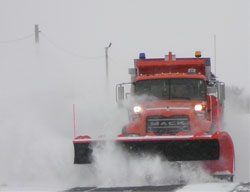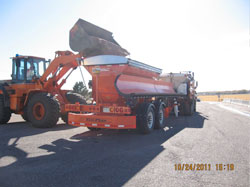Best Practices for Road Weather Management
Colorado DOT One Pass Clearing Operations
Many agencies continue to be challenged with removing snow on an increasing number of lanes and shoulders with the same or fewer trucks and operators, while still needing to meet the public’s expectations. There is a necessity to identify how to plow wider and faster to maintain or increase services without adding personnel. The Colorado Department of Transportation’s (CDOT) original goal was to double operator production to meet the expected levels of service. There are two approaches tried and proven:
- Using wider front plows to clear a 12 foot lane in one pass (see Figure CO-1) has been proven to reduce the number of passes (rounds) needed, has saved fuel and has reduced labor costs. The expected savings for average fuel costs and average labor costs are between 20% and 50%. The benefit to cost ratio exceeds one the first year.
-
Trailer plows, also known as Tow Plows (TP) (see Figure CO-2); have allowed one snow plow truck and one operator to clear widths over 24 feet at high speeds, providing a level of performance never before seen in the industry. Previous trucks with wing plows generally cleared a path of 16 feet or less at speeds less than 30 miles per hour. TPs have cleared up widths up to 25 feet at speeds above 50 mph in open, safe conditions. The benefit to cost ratio exceeds one when it replaces a second truck, and it exceeds one within one year to five years of operation.
System Components: Most transportation agencies use 10-foot, 11-foot, or 12-foot front plows. Using a 14-foot front plow allows one operator to clear one lane in one pass, from centerline stripe across either edge line stripe. The extra cost of 14-foot plows is miniscule compared to the current cost of front plows.
TPs allow one operator to clear widths up to 25 feet, with the ability to vary the clearing path from 11 feet to 25 feet with a simple control in the cab. The TP hooks and tows behind a snow plow truck. In operation, it can be steered into the adjacent lane, clearing and treating an additional lane in the same pass. The TP can be steered around parked cars as needed. The cost of a TP is less than the cost of a conventional snow plow truck.
System Operations: A front 14-foot plow, when properly designed, can vary its clearing path from 11.5 feet at 35 degrees to 12.5 feet at 25 degrees, by using the original control sticks in the cab for other front plows. The former plow position can provide fuel savings due to its acute angle and the latter can clear a 12-foot lane in one pass. It hooks to the trucks just like other front plows.
A TP hooks to a snow plow truck like any trailer with air brakes and it needs controls to deploy. Agencies have used the existing hydraulic controls on wing plow trucks to deploy TPs. One can divert the hydraulics used for existing wing plows to provide steering and moldboard lift. Another option is to add two hydraulic valves and duplicate the front plow control stick. With this option, one stick deploys and retrieves the TP.
TPs with spreaders require additional hydraulic circuits for spreader and fan controls. Some TPs are self-sufficient by having on-board diesel power and hydraulics. Such TP units can be used as brine trailers for anti-icing practices while in tow before a snow storm, or during the storm while deployed.
Transportation Outcome(s): Wider front plows provide tremendous advantages on interstates and expressways because they clear an entire 12-foot lane, thereby eliminating the need for a second round and reducing the exposure time and frequency of exposure between snow plow trucks and traffic.
The practice can also clear both the center line stripe and either the left or right edge line stripes when clearing the 12-foot lane in one pass resulting in exposed stripe markings earlier in the snow storm.
A third advantage is that the practice discharges the windrow beyond the edge lines, positioning it such that it is more difficult for traffic to suck the windrow back onto the pavement between cycles of plowing. In general, two lane collector roads (with and without shoulders) and rural interstates can benefit by clearing the entire lane in one pass.
There has been some indication that eliminating the second plowing round on collector roads (which have adjacent ditches and no shoulders) may eliminate snow plow truck accidents by allowing the operator to discontinue crowding the edge of pavement on the second round. Further, when the operator does not make the second round, he cannot plow off the first pass chemical treatment, thereby eliminating the need to apply a second application of chemicals.
TP trucks can do the work of two snow plow trucks. One such manifestation of this capability is clearing the truck climbing lanes on the first round, and thus immediately returning the climbing lane to service instead of waiting until the second round. Similarly, TPs can benefit routes with reverse passing lanes where snow plow trucks need to clear two lanes for a few miles and then only one lane (and shoulder) for several miles, repeating this alternating passing opportunity for many miles. Therefore, passing opportunities are provided immediately after the first round.
Implementation Issues:
-
Many state transportation agencies have assumed that 14-foot front plows cannot operate on highways. However, the Missouri Department of Transportation now has over 500 plows operating on interstates, expressways, urban multilane signalized areas and collector roads with 10-foot, 11-foot, and 12-foot lanes with and without shoulders.
-
Accessibility to maintenance shops for parking and blade-changing may be an issue; however, the 14-foot plows are designed to pivot farther and the moldboards are clipped to allow entry into buildings.
-
These plows must be used on an appropriately sized truck. The 14-foot plows were first implemented on ten-wheelers but are now used and proven on six-wheelers with gross vehicle weight ratings of 26,000 lbs. or more. These plows are not to be used on lighter trucks. Most trucks have 12,000 lb. front axles or heavier.
-
There may be some concern with the operating width of the 14-foot plows. Plow designs cause the clearing path to always favor the discharge side. Thus, the leading edge is no closer to center line than conventional 11-foot and 12-foot plows. Additionally, the truck mirrors are at least nine feet wide on most trucks. Therefore the front plow is only just outside of the mirrors. Finally, an important benefit of this plow is that it allows the operator to reach the edge of pavement without crowding the steer tire to the edge of pavement.
There are several implementation concerns with the TP, such as the following:
-
“Too large to operate on our highways!” Very few could believe that one could plow two lanes wide with one truck and do it safely. TPs have proven to be safer for gang plowing by eliminating many of the gaps between existing trucks. Brine tanks or spreaders have provided conspicuity for rear recognition to avoid rear end accidents.
-
“Our snow plow trucks do not have enough horsepower to pull.” TPs operate at extreme angles from 60 to 90 degrees compared to front plows which operate at 30 degrees from the rear. This acute angle provides better casting to move snow with less horsepower.
-
“It costs too much.” A TP costs ten times as much as a front plow, but it replaces a second truck and operator.
-
“Our wing plows are being hit from the rear so the TP, being larger, would create more accidents”. All TPs are required to have brine or material spreaders lending conspicuity to the rear. Practice has proven that TPs do not get hit like wing plows.
-
“The TP will not handle our deep snow storms.” Videos of operations in Maine, Canada, and in areas of Ohio with lake effect show that Tow Plows can handle deep snow quite well.
-
“We cannot use a TP truck blocking traffic on a two-lane rural interstate highway.” This had been a major concern, but with field experience it is being overcome. In some cases the use of TPs is preferred and endorsed by the state highway patrol. Seek more information on this issue from the contacts listed below; specifically, Robert G. Lannert can provide current information and states’ practices.
For cautionary purposes, it should be noted that snow plow trucks should always operate at safe speeds for the conditions. Operators should always follow agency protocol and procedures. Operating speeds must consider the equipment design, potential obstacles, the road condition (rutting, potholes, friction, and operating environment), and the operator’s training and abilities. There are major differences in front plow, wing plow, and underbody plow designs where some may not safely operate at speeds above 20 mph to 40 mph, much less than rural interstate speeds. However, plowing faster can reduce or eliminate rear end accidents with snow plow trucks.
Contacts:
-
Robert (Bob) G. Lannert, Retired MoDOT Engineer, Maintenance Operations, (Mr. Lannert’s current telephone number can be obtained via a request through E-mail to MoSnowKing@aol.com).
-
Tim Chojnacki, MoDOT Maintenance Operations, E-mail Mr. Chojnacki at Tim.Chojnacki@modot.mo.gov for current telephone number and information about MoDOT’s experience with more than five 14-foot plows and more than 70 TPs.
-
Phil Anderle. Contact Mr. Anderle at 970-350-2100 or Phillip.Anderle@DOT.State.Co.Us for questions about Speed Management on Colorado I-70 and other routes using Patrol cars and snow plow trucks to maintain safe travel speeds and provide continuous flow of traffic during inclement weather conditions.
Reference(s):
- AASHTO Technical Technology Implementation Group, Tow Plow.
- Snow King Technologies—Current lists are maintained for Tow Plow reports, pictures, videos, and user lists.
- Ohio DOT TowPlow Report, May, 2011.
- Maine DOT Research Division, Technical Brief(10-4), June 2010. Second Year Evaluation of the Viking-Cives Tow Plow.
- Missouri Governor’s Award for Productivity and Innovation in State Government 2007, October 2007. “Fewer Fatalities, TowPlow Invention Recognized.”
- TRB Publication Snow08-003, 2008. “Plowing Wider and Faster on 21st-Century Highways by Using 14-ft Front Plows and Trailer Plows Effectively.” Pages 261-266.
Keywords: One pass clearing, 14-foot snow plow, trailer plow, tow plow, high speed plowing.
previous | next
